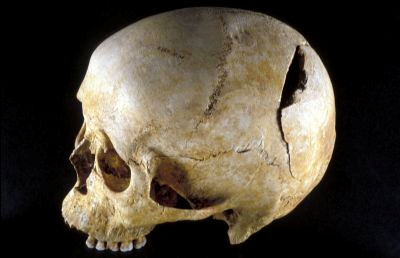
The sample was treated as a 'cross section' of the population although in reality it may represent some ten generations.
The church building itself appears to have been used for the general population, as all ages and both sexes are represented, although slightly more men than women were identified. While the age distribution of the internal burials appears to be approximately that which we would expect, that of the external group was much older, with only one infant and two old juvenile burials. As only a small proportion of the total area was excavated, it seems reasonable to suppose that young children were also buried outwith the church, but that their burial area was not located.
Despite the problems of sample bias and of ageing skeletal material, the age profile of the group was normal in archaeological terms. It seems that whilst most adults survived to middle age few reached old age. Mortality during childhood was probably caused by conditions seen as insignificant in the West today, such as measles and diarrhoea, although these diseases continue to be major killers in the developing world. Frequent episodes of malnutrition and/or ill health are indicated by the short stature by modern standards, and by the frequency of enamel hypoplasia.
Archaeologically it seems reasonable to divide the population into those recovered from the confines of the church and those recovered from outside it. Burial within church buildings was probably a privileged event, associated with wealth and/or high social status. We may therefore expect to see differences between the groups, perhaps in terms of stature or in markers of nutritional deficiency indicating the relative wealth of the group. Unfortunately, because the external burials were generally both less complete and in poorer condition than the internal burials, no valid comparisons could be made, although there did seem to be significant differences in the number of individuals displaying copper alloy stains. However, even if status differences did exist, evidence from Schmorl's nodes suggests that both groups were equally exposed to spinal stresses causing these lesions, indicating similar levels of arduous physical activity in both groups that were greater than those generally seen in other groups of similar period.
Cnemic and meric indices were used as indicators of lower limb shape. Both the femur and the tibia fell towards the 'rounded', 'modern' end of the reported ranges for archaeological groups. There seems to be no association between the indices and stature as might be expected if lower limb shape were largely determined by nutrition.
The frequency and distribution of fractures was unremarkable and all could have been caused by accidental, indirect trauma. However, blade injuries to at least one skeleton indicate probable interpersonal violence.
Schmorl's nodes were especially common, indicating that most men and women were subject to significant spinal stress, probably of a compressive nature. Frequencies appear to be amongst the highest reported for archaeological populations. The pattern of involvement of male and female spines was different, with women being primarily affected in the thoracic spine whereas men were more evenly affected, a similar pattern to that seen in other sites (e.g. Cardy 1997a). Explanations for the frequency of Schmorl's nodes remain obscure as their development is incompletely understood, as is their significance. They are often undetectable from x-rays and modern frequencies and patterns of distribution are therefore unclear. Levels of spinal stress are also indicated by the high incidence of spondylolysis in the fifth lumbar vertebral region.
The distribution of defects of the articular surfaces was interesting. The bones most affected appeared to be the same as those observed at other sites although the overall frequencies were low. Of especial note was the complete absence of defects of the articular surfaces in the second cervical vertebra compared with frequencies of up to 12% in other sites. The significance of defects of the articular surfaces, if any, is unknown.
The frequency of cribra orbitalia in immatures suggests that iron deficiency anaemia, scurvy or eye infection was common. The low frequency in adults suggests that either a large proportion of those with cribra died as children or that lesions healed and were obliterated with age. In reality a combination of the two is likely. There were no cases of severe cribra in the group, most being of either slight or moderate degree.

The Medical School in Aberdeen was one of the first to be set up in Britain. A Professor of Medicine was appointed in 1609, and so it would seem likely that there was the possibility of medical intervention for at least a proportion of the population. In the present sample, this was limited to the series of scratches on the parietal of SK 239 [Photo 0316], appearing to represent an attempt to treat the blade wound. Medical interventions such as herbalism, tooth pulling and bone setting were undoubtedly practised but cannot be distinguished in archaeological remains.
Internet Archaeology is an open access journal based in the Department of Archaeology, University of York. Except where otherwise noted, content from this work may be used under the terms of the Creative Commons Attribution 3.0 (CC BY) Unported licence, which permits unrestricted use, distribution, and reproduction in any medium, provided that attribution to the author(s), the title of the work, the Internet Archaeology journal and the relevant URL/DOI are given.
Terms and Conditions | Legal Statements | Privacy Policy | Cookies Policy | Citing Internet Archaeology
Internet Archaeology content is preserved for the long term with the Archaeology Data Service. Help sustain and support open access publication by donating to our Open Access Archaeology Fund.